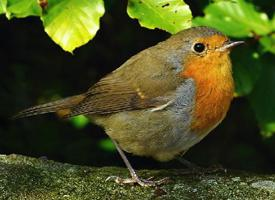
Váhy a míry
| Délka | od 12 do 14 cm |
|---|---|
| Hmotnost | od 16 do 18 g |
| Délka rozpětí křídel | 22 cm |
Biologická data
| Délka života | od 1 do 12 let |
|---|
Popis zvířete
The European robin (Erithacus rubecula), often simply known as the robin, is a small passerine bird that holds a special place in the hearts of many, especially in Europe where it is a common sight in gardens and woodlands. This charming bird is easily recognizable by its round shape, warm orange-red breast and face, bordered with grey to brown sides, and a white belly. The rest of its plumage is a brownish-grey to olive color, which provides excellent camouflage in its natural woodland habitat. Both male and female robins look similar, making it challenging to differentiate between the sexes based solely on appearance.Adult European robins measure about 12.5–14.0 cm in length, with a wingspan of 20–22 cm, and weigh approximately 16–22 grams. Despite their small size, robins have a robust and pugnacious character, especially when it comes to defending their territory. They are known for their distinctive and melodious song, which can be heard throughout the year, but is most prominent during the breeding season. The song is a series of rich and varied warbles, often delivered from a prominent perch in their territory.
The European robin has a wide distribution, being found across Europe, western Asia, and parts of North Africa. Its habitat ranges from dense forests to open gardens and parks, showing a remarkable adaptability to different environments. This adaptability, along with a diet that includes a wide variety of insects, spiders, worms, and berries, allows the robin to thrive in areas where other birds might struggle.
Breeding season for robins begins in late March through to August. They are monogamous during the breeding season, with both parents taking part in raising the offspring. The female builds a cup-shaped nest in a concealed location, often on the ground or in a dense bush, where she lays a clutch of 4-6 light blue eggs. The eggs hatch after about two weeks, and the chicks are fed by both parents until they are ready to fledge, about 14 days later.
Robins have a strong association with humans and have been featured prominently in European folklore and culture, often symbolizing hope and renewal. This connection is perhaps most evident during the Christmas season, where the robin frequently appears on greeting cards and decorations.
Despite facing threats from habitat loss and climate change, the European robin is currently classified as Least Concern by the International Union for Conservation of Nature (IUCN), thanks to its wide range and large population. However, continued conservation efforts are necessary to ensure that this beloved bird remains a familiar and cherished sight in its natural habitat.
Podobná zvířata
Nové fotografie zvířat
Top 10 zvířat
- Dolphin gull (Leucophaeus scoresbii)
- Diana monkey (Cercopithecus diana)
- Moustached guenon (Cercopithecus cephus)
- Galápagos tortoise (Geochelone nigra complex)
- Japanese macaque (Macaca fuscata)
- Stone loach (Barbatula barbatula)
- Russian tortoise (Testudo horsfieldii)
- Greek tortoise (Testudo graeca)
- Common flying dragon (Draco volans)
- Vendace (Coregonus albula)


